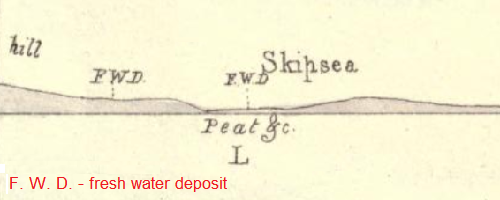Reference (snippet)
Phillips, John (1829)
Illustrations of the Geology of Yorkshire, or a Description of the Strata and Organic Remains of the Yorkshire Coast
York: Thomas Wilson
From page 66:
...the pebbly clay sinks below the level of high water, and forms a wide hollow, in which is an extensive and interesting lacustrine deposit, (L). Its length is about a quarter of a mile, its extreme elevation above high water at the south extremity, is twelve feet, but in the middle only four or five feet. The series of depositions from fresh water is as follows:
[Field note] Peat. Its utmost thickness is seven feet: where this happens, the lower four feet six inches are solid and break like clay. The upper part is then fibrous. Yellowish clay, full of padulina tentaculata, cyclas cornea, and a few speciments of lymnaea stagnalis. This is seen only on the southern side of the hollow. Blue clay, full of cyclads. Here is some phosphate of iron. This rests upon gravel, under which is blue clay.
Section of the cliffs on the coast of Yorkshire, 2 [rear of book].
